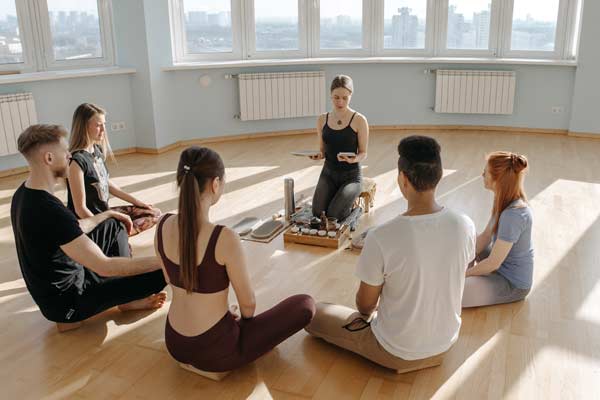Many people end up on a yoga mat to attain specific goals. Whether it is bigger stamina, a relaxed mentality, or a thinner reflection in the mirror, Yoga is about the process, not the progress.
Feeling and seeing the improvement remains the best inspiration to focus on the process of moving forward in the yoga journey.
There are very few restrictions governing Yoga, which comprise the amount of time you spend practicing each yoga session. A basic yoga class lasts about 60 minutes. Other yoga practices last 90 minutes or longer.
There are special classes that last between 30 to 45 minutes. These classes are offered mainly by workplaces that provide fitness and wellness classes to their employees.
Some online yoga practices last between 5 to 20 minutes. Hence you can squeeze in a yoga session in your busy schedule anytime, especially if you are a yoga enthusiast.
Categories of Yoga
Various yoga types depend on your demands, whether physical or mind-relaxing. This guide explores the major types that will help you understand each of them before you select the one that suits you.
1. Hatha Yoga
Hatha is a yoga practice that merges asana, pranayama, and meditation. These yoga classes are suitable for newbies since they consist of slow postures than other yoga styles. Hatha is always considered to be a relaxing flow. This is the best entry point if you are a newbie to Yoga.
2. Vinyasa Yoga
Vinyasa yoga is deemed the most energetic style of Yoga. It combines breathing and movement. Vinyasa creates a sequence of positions with controlled breathing imitating the flow of life. The styles can differ depending on the coach.
3. Kundalini Yoga
It consists of both physical and spiritual yoga practices. This class is suitable for strengthening intuition and willpower, especially when you are low on physical and mental stamina. Kundalini yoga can comprise verses, singing, and meditation.
4. Ashtanga Yoga
It involves a series of physically demanding postures. Hence, Ashtanga Yoga is not recommended for beginners. It takes experienced yogis to love the practice.
5. Iyengar Yoga
Iyengar yoga majorly concentrates on alignment and detailed movements while holding your breath. Poses are usually held longer in this Yoga. Its primary purpose is to help students go deeper into postures comfortably. It would help if you considered It in case you have injuries.
6. Yin Yoga
Yin is a beginner class. The postures are kept for a short time, between 45seconds to 2 minutes. This Yoga encourages one to relax and let the universe do the most.
7. Restorative Yoga
This is the best Yoga for you if you want to wind down and relax your mind after a long day. Restorative Yoga focuses on body relaxation.
8. Prenatal Yoga
Prenatal Yoga is mainly for expectant women. It is customized for women in all trimesters.
It is considered the best exercise for expectant mothers because the pelvic base work focuses on breathing, promoting a bond with the growing baby.
9. Anusara Yoga
Anusara yoga is a modern version of Hatha Yoga. It is popular for its emphasis on heart opening. Its primary focus is on the mind, heart body connection.
10. Jivamukti Yoga
This is majorly Vinyasa classes merged with Hindu spiritual teachings. Jivamukti yoga has 5 principles incorporated with a sequence of postures that go hand in hand.
11. Bikram Yoga
It features a series of poses in a 105 degrees temperature room. Bikram yoga has 26 basic postures that focus on proper alignment. Each posture is performed twice.
How Often You Should Practice Yoga
How many times you should practice Yoga depends on various factors. They include:
- Spiritual motives.
- Existing fitness levels.
- Your health and fitness objectives.
- How many times do you work out?
If you do weights, cardio, and sports regularly, you may want to go for 2 to 3 yoga sessions a week. In such a scenario, you must choose a type of Yoga that goes hand-in-hand with your training.
For instance, if you lift weights in the gym three times a week, you would benefit from gentle Hatha or yin yoga practices. The two yoga practices focus on alignment and flexibility of the muscle; hence you would have achieved balance.
If you are not planning to do any workouts apart from Yoga, you can practice at least 6 times a week. Since the training will be frequent, your sessions could be 15 to 30 minutes long.
If you want to use Yoga to reduce stress and anxiety, you can practice Yoga daily as long as you are not overdoing it. Yin yoga is the best for this goal. You can also add other exercises, such as pranayama and meditation, into your routine.
Daily yoga practice will burn you out quickly, especially lifting weights. For strength and muscle gain, 2 to 3 yoga sessions are recommended weekly. A Hatha, restorative, or yin yoga would work best in such a case to improve flexibility.
If you only use Yoga to gain strength, you can practice Vinyasa or Ashtanga daily. They would work best. Your goal could be to get ripped; hence you will require to practice healthy eating and training consistently.
Since healthy eating involves reducing the number of calories you take, training every day will be an excellent task. In this case, 2 to 3 restorative yoga sessions will work well.
However, if you are not practicing other exercises apart from Yoga to get ripped, look for a flowing vinyasa class. Vinyasa aims at building heat all over the body, which can result in burning calories. Thus, you will be sweating profusely at the end of every session.
To sum up, whether you are training twice or daily a week, the most critical factor is consistency in achieving your yoga goal.
